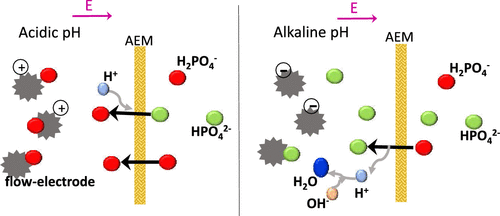当前位置:
X-MOL 学术
›
Environ. Sci. Technol.
›
论文详情
Our official English website, www.x-mol.net, welcomes your
feedback! (Note: you will need to create a separate account there.)
pH Dependence of Phosphorus Speciation and Transport in Flow-Electrode Capacitive Deionization.
Environmental Science & Technology ( IF 10.8 ) Pub Date : 2020-06-25 , DOI: 10.1021/acs.est.0c01836 Yanhong Bian 1 , Xi Chen 1 , Zhiyong Jason Ren 1
Environmental Science & Technology ( IF 10.8 ) Pub Date : 2020-06-25 , DOI: 10.1021/acs.est.0c01836 Yanhong Bian 1 , Xi Chen 1 , Zhiyong Jason Ren 1
Affiliation

|
Electrochemical processes such as capacitive deionization have shown great promise for salt removal and nutrient recovery, but their effectiveness on phosphate removal was lower than other charged ions. This study hypothesized that the speciation and transport behaviors of phosphate ions are highly influenced by electrolyte pH, and it used experimental and modeling approaches to elucidate such impacts in flow-electrode capacitive deionization (FCDI) cells. Phosphate removal was investigated in either constant current (CC) or constant voltage (CV) charging mode with pH ranged from 5 to 9 in the feed solution. Results showed that the average P removal rate increased from 20.8 (CC mode) and 16.8 mg/min (CV mode) at pH 9 to 38.3 (CC mode) and 34.3 mg/min (CV mode) at pH 5 (84–104% in improvement), respectively. Correspondingly, the energy consumption reduced from 1.04 kWh/kg P at pH 9 to 0.59 kWh/kg P at pH 5 (42.9–56.1% in saving). Such benefits were attributed to the shift in dominant P-species from HPO42– to H2PO4–. Conversely, high-electrolyte pH (pH = 11) for flow-electrode led to ∼74.8% higher phosphate recovery during discharge compared with pH 5, which was associated with the higher distribution of phosphate ions in the electrolyte versus on the flow-electrodes due to surface charge change. These results improved our understanding in ion distribution and migration and indicate that solution pH is critical for operating FCDI reactors. It shed lights on the best practices on electrochemical phosphate removal and recovery.
中文翻译:

流动电极电容去离子中磷形态和运输的pH依赖性。
电化学过程(例如电容性去离子)已显示出脱盐和养分回收的巨大希望,但它们对磷酸盐的去除效果却低于其他带电离子。这项研究假设磷酸根离子的形成和传输行为受电解质pH的影响很大,并且它使用实验和建模方法来阐明在流电极电容去离子(FCDI)电池中的这种影响。在进料溶液中,以恒定电流(CC)或恒定电压(CV)充电模式研究了磷酸盐的去除,pH范围为5至9。结果表明,平均pH去除率从pH 9的20.8(CC模式)和16.8 mg / min(CV模式)增加到pH 5的38.3(CC模式)和34.3 mg / min(CV模式)(84–104%)改进中)。相应地,能耗从pH 9的1.04 kWh / kg P降低到pH 5的0.59 kWh / kg P(节省42.9-56.1%)。这些好处归因于HPO主导的P物种的转移4 2–到H 2 PO 4 –。相反,与pH 5相比,流动电极的高电解质pH(pH = 11)导致放电过程中的磷酸盐回收率高出约74.8%,这与电解液中磷酸盐离子在流动电极上的分布较高有关。表面电荷的变化。这些结果改善了我们对离子分布和迁移的理解,并表明溶液的pH值对于运行FCDI反应器至关重要。它阐明了电化学磷酸盐去除和回收的最佳实践。
更新日期:2020-07-21
中文翻译:

流动电极电容去离子中磷形态和运输的pH依赖性。
电化学过程(例如电容性去离子)已显示出脱盐和养分回收的巨大希望,但它们对磷酸盐的去除效果却低于其他带电离子。这项研究假设磷酸根离子的形成和传输行为受电解质pH的影响很大,并且它使用实验和建模方法来阐明在流电极电容去离子(FCDI)电池中的这种影响。在进料溶液中,以恒定电流(CC)或恒定电压(CV)充电模式研究了磷酸盐的去除,pH范围为5至9。结果表明,平均pH去除率从pH 9的20.8(CC模式)和16.8 mg / min(CV模式)增加到pH 5的38.3(CC模式)和34.3 mg / min(CV模式)(84–104%)改进中)。相应地,能耗从pH 9的1.04 kWh / kg P降低到pH 5的0.59 kWh / kg P(节省42.9-56.1%)。这些好处归因于HPO主导的P物种的转移4 2–到H 2 PO 4 –。相反,与pH 5相比,流动电极的高电解质pH(pH = 11)导致放电过程中的磷酸盐回收率高出约74.8%,这与电解液中磷酸盐离子在流动电极上的分布较高有关。表面电荷的变化。这些结果改善了我们对离子分布和迁移的理解,并表明溶液的pH值对于运行FCDI反应器至关重要。它阐明了电化学磷酸盐去除和回收的最佳实践。











































 京公网安备 11010802027423号
京公网安备 11010802027423号